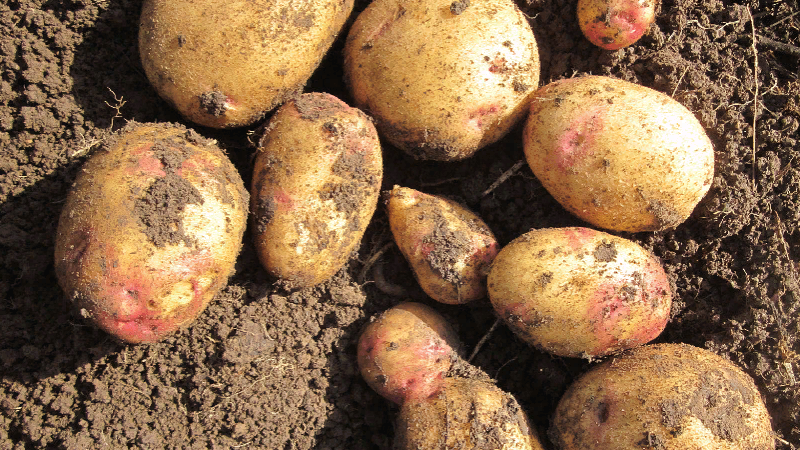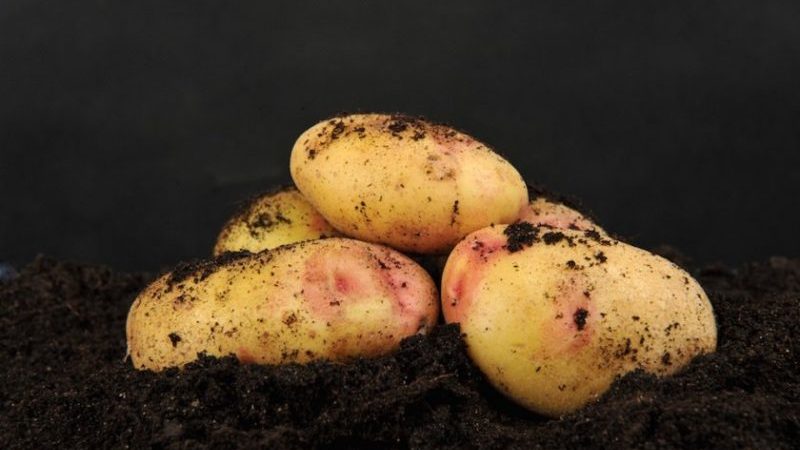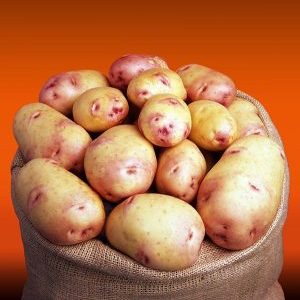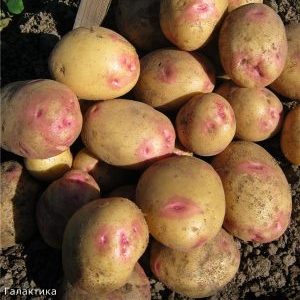Potato variety Galaktika with excellent taste and long shelf life
The new Irish potato variety Galaktika has already gained popularity among vegetable growers due to its outstanding characteristics. The culture gives an early harvest and has a strong immunity to late blight, which is dangerous for potatoes. The plant adapts to different climatic conditions and forms at least 10-14 tubers per bush. The vegetable tastes great and has a long shelf life. Even an inexperienced summer resident or farmer can cope with the cultivation of the Galaxy variety.
The content of the article
Potato Galaxy: variety description
The upright plant reaches a height of about 120 cm. The powerful stems have a slight ribbing and a smooth green surface. The bush produces branches up to 30 cm long. The size of the pinnately dissected leaves is large, the color is dark green. The flowers have a purple hue with a yellow core.

Origin and development
Potato variety Galaktika is relatively new in the domestic market. The root crop was developed by Irish breeders. Initially, experts planned to get an early-ripening variety that would be invulnerable to late blight, but additionally paid attention to the taste and shelf life. The culture passed all varietal tests and in 2008 was included in the State Register of the Russian Federation.
Chemical composition, trace elements and vitamins
There is a large amount of starch in potatoes - about 15-18%. The concentration of this substance directly depends on the nutritional value of the soil on which vegetables are grown. On well-fertilized soils, the starch level will be higher.
Potatoes Galaxy refers to dietary varieties. Per 100 g of product calorie content is no more than 80 kcal. Also, tubers contain a significant amount of organic acids, there are vitamins, carotenoids, macro- and microelements. The fat concentration per 100 g is only 0.6%.
Ripening period
Galaktika potatoes are early varieties. Root crops fully ripen 90 days after landing... Irish potatoes have excellent palatability, stable yields and strong immunity to pests and most fungal diseases.
Yield
The tubers themselves are medium in size. The standard weight of one potato is 90 g. Up to 13-14 root crops ripen in the hole. With good care from 1 hectare of planting, vegetable growers collect up to 300 centners of potatoes (an average of 250 centners).
Disease resistance
Diseases to which the variety Galaktika is immune:
- Alternaria. A characteristic sign of infection is the appearance of dark brown or brown spots on the leaves, which are clearly visible 2-3 weeks before flowering. With a high degree of damage, the foliage turns yellow and falls off.
- Late blight. A diseased bush differs from a healthy one in tiny, but rapidly increasing brown spots on the leaves, which gradually pass onto the stem itself.In dry weather, the infected plant dries up, in rainy weather it begins to rot.
- Potato cancer... This is a fungal disease that affects tubers, stems, leaves. They become covered with warty growths, and the roots become unsuitable for human consumption, quickly deteriorate and rot.
- Rhizoctonia. The most common symptom of the disease is deep dark spots, as well as net necrosis. The roots of the potato gradually rot, and the leaves of the plant fall off. With high humidity and in loamy soil, parasitic bacteria develop much faster.
Characteristics of tubers, description of appearance
The shape of the potato is round-oval. Smooth tubers are creamy with few pink eyes and small brown spots. The pulp has a yellow tint, with cooking crumbles.
Which regions is best suited for
Potatoes Galaxy is suitable for growing in various climatic conditions. It is recommended for cultivation in the North-West, Central and Volga-Vyatka regions, but it is successfully grown practically throughout the entire territory of Russia, Belarus and Ukraine.
The main advantages and disadvantages of the variety

Advantages of the Galaxy variety:
- stable yield;
- high marketability and taste;
- resistance to bacterial and viral diseases;
- adaptation of culture to different climates;
- long shelf life of vegetables.
Disadvantages:
- medium resistance to scab;
- at the time of harvesting, not all of the tops dries up, so it is difficult to determine the maturity of the potatoes.
What is the difference from other varieties
Potatoes Galaxy grows well and produces bountiful crops in temperate climates. He is unpretentious and forgives care mistakes.
Features of planting and growing
To obtain a plentiful and high-quality harvest, it is important to properly prepare the seed material, choose the time for planting, moisturize and fertilize the crop.
Preparing for landing
Exceptionally healthy tubers are chosen for growing potatoes. The larger they are, the more they will retain nutrients, so the root system will develop better. The preparation of planting material has several features:
- Before planting, the seeds are placed in a warm, sunny place. The rind will coarsen and turn green, which will accelerate growth.
- Ultraviolet rays sterilize seeds well, destroying bacteria and fungal microorganisms.
- Choose tubers with sprouts up to 1 cm, otherwise the risk of breaking them during planting increases.
- Sprinkle the tubers with wood ash.
Ground requirements
The culture loves light sandy loam soil rich in organic fertilizers. In heavy soil, tubers will develop slowly. In this case:
- River sand is added to the soil.
- When digging, organic matter is introduced. If there are no such fertilizers, they add cut grass, straw, tops, which are left over from previous crops. The procedure is carried out during autumn plowing, since fertilizers do not have time to form in spring.
Timing, scheme and landing rules
The exact timing of planting potatoes is extremely difficult to determine, given the characteristics of different regions, and sometimes climatic conditions:
- They are planted in a heated soil, otherwise the plants will not sprout in the right time. Staying seeds in cold soil will result in the loss of the entire crop.
- In the spring, a month before planting, they dig up the soil.
- The potatoes are planted so that 70 cm remains between the rows, and 40 cm between the bushes. This facilitates the care of the crop and promotes the full growth of the tubers.
- The holes are dug 15–20 cm deep.
- As a fertilizer, they are placed in 100 g of chicken manure.
- Next, planting material is laid and sprinkled with earth, forming a small mound on top.
It is popularly believed that it is time to start planting potatoes as soon as the birch buds bloom.
Growing features
Potatoes are successfully cultivated in the vast majority of regions of Russia.The culture is grown in summer cottages for personal use and on farms for sale. The cultivation technology is practically no different from the cultivation of other varieties.
The nuances of care
In hot weather, to preserve moisture in the soil, mulching the beds is done. To do this, use straw, grass or peat. Additionally, mulching protects against sudden cold weather.
Watering mode
The variety does not tolerate excessive watering, often gets sick when growing near water bodies:
- after planting, 1 to 2 liters of water are used per plant;
- in hot weather, watered moderately, while spending about 2 liters of water per 1 bush;
- also apply drip irrigation using the same volume of liquid.
Top dressing
During the growing season, the culture is fed. Mineral fertilizers are added carefully, as there is a risk of making a mistake with the dosage:
- In the fall, when preparing the beds, about 5-7 kg of rotted manure and 15 g of potassium sulfate per 1 m² are used.
- In the spring, before planting potatoes, half a bucket of peat manure or compost is introduced into the soil on 1 m². Also add 20 g of ammonium nitrate, potassium sulfate and 30 g of nitrophoska per 1 m².
- During the growing season, before hilling on 1 m², use a solution of 0.5 buckets of water and chicken droppings in a ratio of 1:10. Then watered abundantly.
Weeding and hilling
Hilling is a mound of soil at the stem of a plant in the form of a slide. This procedure has several functions:
- keeps the plant from adhering to the ground;
- saturates the soil with oxygen;
- cleans the garden from grass.
When hilling, the yield increases. It is carried out 2 times per season: when the bush reaches 20-25 cm, and then after 2-3 weeks.
For your information.The third hilling is necessary if the soil has been washed away by rain or watering, and potato roots have appeared on the surface.
If the soil warms up more than + 25 ° C, and the air temperature is + 30 ° C, the hilling of the plants is not performed. Under such conditions, they loosen the soil surface and get rid of weeds.
Disease and pest control
Galactica potatoes are affected by such diseases and pests:
- Scab... Typical signs are shallow ulcers of a concave, reticular, convex, flat shape on the surface of tubers. Deformation affects not only the skin, but also the pulp of the tubers. The scab is destroyed by spraying the plants with Fitosporin M. For the entire growing season, the procedure is carried out 3 times. To prepare a solution, a package of substances is diluted in 3 liters of water or follow the instructions. Also, when a disease occurs, a solution of "Kuproksat" is used, stirring 25 g of the substance in 10 liters of water. The second spraying is carried out after 10 days, but no later than 20 days before harvesting.
- Stem nematode. This worm, up to 1 mm in size, infects plant stems and tubers. It is easy to recognize a vegetable in which pests have settled: tiny dark spots will be clearly visible on the peel. In the case of severe damage, the shell cracks, dust forms under it (dry rot). The stem nematode reproduces intensively in a humid environment. They get rid of the pest with the drug "Bazudin".
- Wireworm. This is the larva of the click beetle, it is a yellow-brown worm 2-3 cm long with a rather dense cover. The adult (adult) is a black beetle with an oblong body up to 5 cm long. The pest is fought with nitrogen-containing fertilizers. Such drugs include: ammonium sulfate (30 g per 1 m²), ammonium nitrate (20 g per 1 m²), ammonium chloride (30 g per 1 m²). The means are introduced into the soil, and the pests feel the pungent smell of ammonia, which is unpleasant for them. They also fight the wireworm with the drug "Aktara" - the agent is dissolved in water to process the potatoes before planting (1 g per 10 l of water), or dry powder is added to the holes.
- Colorado beetle. The pest feeds not only on green shoots of potatoes, but also on tubers, especially in spring, when green shoots have not yet made their way out of the ground.During this period, it is easy to fight the beetle using traps. Chopped potatoes are used as bait. The Colorado potato beetle is destroyed by spraying potato bushes with a urea solution. To prepare 100 g of the substance, dissolve in 10 l of water. Processing is carried out in the morning or evening. Many vegetable growers use the "Confidor" product (according to the instructions).
To combat pests, onion husks, wood ash or mustard powder are added to the holes during planting.
Harvesting and storage
Potatoes are fully ripe 90 days after planting. This is the main reference point for harvesting, since the tops of the Galaktika variety do not dry out before harvesting.
How and when to collect
To make sure that the potatoes are ripe, first dig out one bush. If the skin is tight, it's time to start picking vegetables:
- Dig up potatoes with a shovel or mechanical device (walk-behind tractor, combine).
- Before putting tubers in bags, they are dried in the open air under sunlight for no more than 2 hours. They do not keep it any longer, otherwise poisonous substances will begin to be produced in the peel.
- Damaged tubers are discarded, the seed is sorted.
Storage features and keeping quality of the variety

After harvest, the crop is kept in boxes in a dry and cool room, for example, a basement. After 4 weeks, the potatoes are sorted out again and the unusable tubers are discarded.
Vegetables are stored in the cellar for up to 7 months at an air humidity of no more than 80%. They are less susceptible to damage, so they are perfectly transported over long distances and do not deteriorate on the road.
What can be the difficulties in growing
Many villagers grow potatoes in the same place for 10-15 years in a row. It is not easy for private owners to follow the rules of crop rotation. The reason is small land plots. However, there is a simple and effective way out.
At the first opportunity, they acquire new seeds or exchange planting material with neighbors. Each seed potato develops much more intensively in a new place for itself.
Tips from experienced gardeners
Recommendations before planting in spring:
- It is best to plant medium-sized tubers or cut large roots so that each part has several eyes.
- Deep-planted tubers will provide small change and abundance of tops.
- It is better to feed the crop with chemical fertilizers. Organic matter, especially manure, negatively affects the taste of vegetables.
- To get large, tasty tubers, slightly crush the tops. After that, nutrients are consumed exclusively for the development of the potato. It is necessary to carry out such a procedure 1-2 weeks after flowering.
- If the leaves begin to turn black from late blight, the affected areas are immediately cut off and burned.
- Horseradish, calendula, aromatic herbs are planted along the edges of the potato field - they all have a beneficial effect on his health.
- Coriander, catnip, nasturtium, tansy, marigolds scare off the Colorado potato beetle. They are planted along the edge of potato beds.
- Sunflower has a depressing effect on potatoes.
Reviews of the variety Galaxy
Experienced vegetable growers generally speak positively about the Galaxy variety. Culture grows well in the overwhelming majority of regions of Russia.
Vladimir, Oryol: “I've been growing potatoes for a long time. In general, I really love this product. During my life I have tried many varieties. When new ones appear, I experiment with them. Several years ago, he grew the Galaxy. I liked the variety. The potatoes are very tasty and have a long shelf life. I advise everyone!".
Tatiana, Chita: “I have acquired mini-tubers of the Galaxy for the dacha because of their productivity and unpretentiousness. Potatoes grow large, on average weighing 80-90 g. I have not yet observed bacterial diseases. I traditionally fight the Colorado potato beetle with pesticides. Potatoes keep well until spring. The root vegetables taste great. I even took a photo of vegetables to show and recommend this variety to neighbors.I will continue to grow it ”.
Read also:
Conclusion
Even a novice gardener can handle the cultivation of potatoes Galaktika. However, one should not rely on the undemanding variety - without proper care, there will be no serious result. Subject to the agrotechnical rules, the Galaxy variety will thank its owners with a plentiful and tasty harvest.